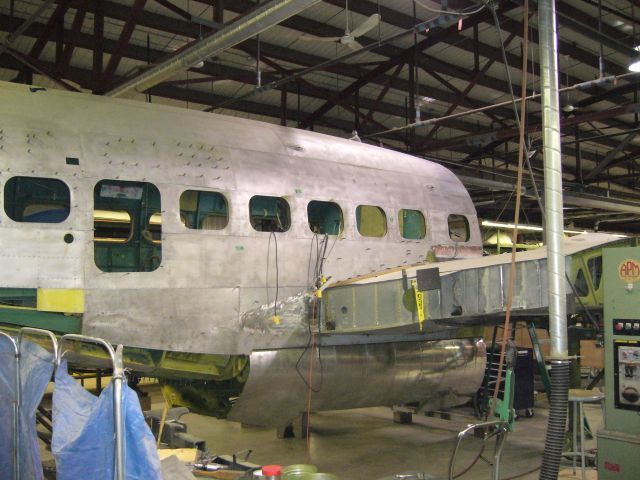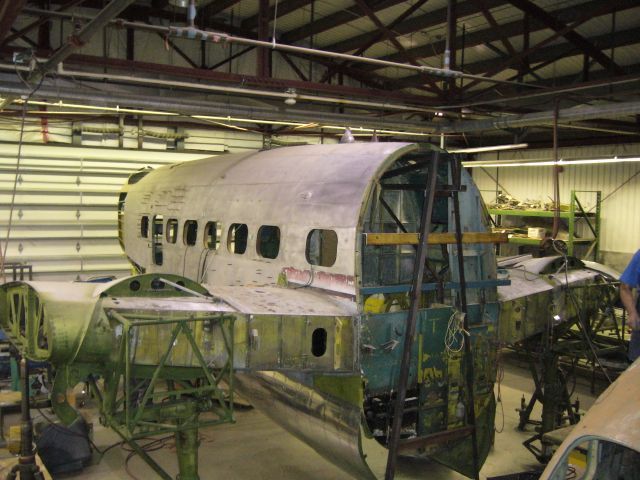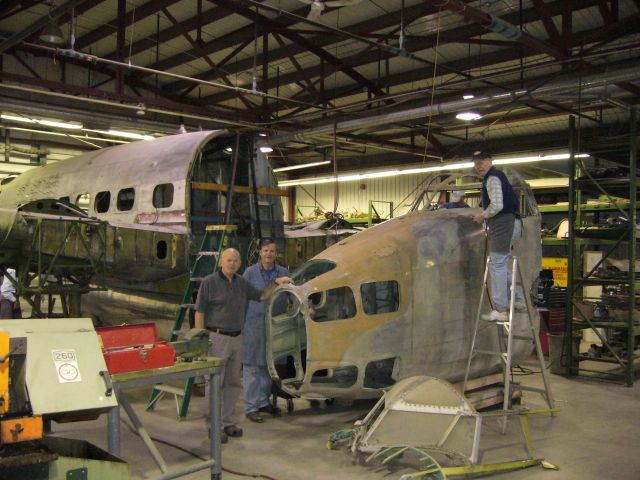Lockeed Hudson Restoration at CFB Trenton
Sun Dec 09, 2012 8:20 pm
Found a link to with a pic of the Hudson at NMUSAF. Looks like they are doing it right. On a side note why is the Hudson type not in the registry? I'm assuming this is the a/c from Colorado since it left a couple of years ago.
http://www.flickr.com/photos/steelhead2010/7286367802/
http://www.flickr.com/photos/steelhead2010/7286367802/
Last edited by PinecastleAAF on Mon Dec 10, 2012 11:41 am, edited 1 time in total.
Re: Lockeed Hudson Restoration at Dayton
Sun Dec 09, 2012 8:26 pm
The aircraft at Dayton is a VEntura. I believe the Hudson in the pics is being restored at the RCAF Museum in Trenton Ontario.
SN
SN
Re: Lockeed Hudson Restoration at CFB Trenton
Sun Dec 09, 2012 8:30 pm
Oopsie!.
Re: Lockeed Hudson Restoration at Dayton
Sun Dec 09, 2012 9:09 pm
I just watched a very good video on transporting Hudsons to England over the North Atlantic, it was called "Above and Beyond" I got it on Amazon. It's about 3 hours long and is not a documentary.
Re: Lockeed Hudson Restoration at Dayton
Sun Dec 09, 2012 9:09 pm
No problem! Just to confirm, the aircraft is a Lockheed Hudson Mk.VI, FK466, and is being 'done right' when I saw it in June, and is being restored at (what is now correctly known as ~ I've got it wrong before) The National Air Force Museum of Canada, at Trenton, Ontario. The NMUSAF doesn't have a Hudson and should, and the same goes for the registry - except we can get told to 'put up or shut up' for the latter! (If anyone starts a Hudson register, I can provide pics of most of the survivors.)
The history of this aircraft and the restoration is here: http://airforcemuseum.ca/en/restoration ... estoration
Regards,
The history of this aircraft and the restoration is here: http://airforcemuseum.ca/en/restoration ... estoration
Regards,
Re: Lockeed Hudson Restoration at Dayton
Sun Dec 09, 2012 11:59 pm
JDK wrote:(If anyone starts a Hudson register, I can provide pics of most of the survivors.)
And I can provide a picture of the one that everybody seems to miss when they come up with a list of the survivors!
Re: Lockeed Hudson Restoration at Dayton
Mon Dec 10, 2012 11:33 am
I agree with James that the NMUSAF should have a Hudson - that said I am not sure if there enough available airframes to enable another restoration.
The part played by the Hudson crews in defending the East Coast of North America and the Caribbean against the Axis U-boats is perhaps not as well recorded as it should be. The recent FlyPast’s “Spotlight” feature on the Lockheed Hudson barely mentioned it.
The following is of note and comes mainly from uboat.net:
The first confirmed sinking of a German submarine (U-656) by any of the Forces of the United States was on March 1st, 1942 by depth charges dropped from a US Navy Lockheed PBO-1 (Hudson) flown by Ensign William Tepuni and crew of VP-82 operating out Argentia, Newfoundland.
Fourteen days later another PBO-1 Hudson of VP-82 out of Argentia, flown by CPO Donald Mason made the second confirmed victory when his crew sank U-503.
VP-82 had become the first USN Patrol Squadron to operate land-based aircraft when it received twenty Hudsons diverted from RAF orders in late 1941.
First successful attack by the USAAF resulting in the confirmed sinking of a German submarine (U-701) was made on July 7th 1942 by a Lockheed A-29 (Hudson) flown by Lt Harry J. Kane and crew of the 396th Bombardment Squadron operating out of MCAS Cherry Point, North Carolina.
The first confirmed sinking of a German submarine by the RCAF occurred on July 31, 1942 when S/L. N.E. Small and his crew of No.113(BR) Squadron in Hudson IIIA BW625 operating out of Yarmouth, Nova Scotia sank U-754.
Added to this is the dramatic story behind the capture of the U-boat exhibited in the Chicago Museum of Science and Industry due, in part, to the heavy damage it received during an attack by a RAF No.53 Squadron Hudson based in the West Indies, twenty months earlier.
Much of the USA’s, Canada’s and ultimately, Britain’s supplies of bauxite ore (aluminium) and oil were shipped across the Caribbean, and this did not pass unnoticed by Admiral Doenitz. For a period during 1942 a greater tonnage of Allied shipping was lost to U-boats in the Caribbean than anywhere else. In July 1942, No.53 Squadron with twenty radar-equipped and torpex depth charge armed Hudsons were posted from the UK, first to Quonset and then to Trinidad to assist in the war against the U-boats and to escort the convoys.
The RAF squadron was unable to actually sink a U-boat during the four months it was active in the region, though they damaged several and probably kept a lot heads down. The RAF operated alongside such as US Navy PBY and PBM Patrol Squadrons and USAAF B-18A/Bs Bombardment Squadrons which had a number of hard fought successes over the U-boats in the region.
On November 10th, an Australian pilot with 53 Squadron, F/Sgt Sillcock and his crew (1 RNZAF, 2 RAFVR and 1 US Navy) caught a U-boat on the surface. One of the four accurately placed depth charges actually struck the gun platform to the rear of U-505’s conning tower and exploded on impact causing severe damage and crippling the U-boat. Debris from the explosion is thought to have struck the very low flying Hudson which immediately exploded and crashed in the sea nearby – all five men being killed.
The recently appointed captain was already losing the respect of U-505’s experienced crew. They now blamed his lack of watch keeping for the success of Hudson’s surprise attack. He did however get his crippled vessel back to it’s home port in France – apparently the most seriously damaged u-boat to return from a long patrol. After over six months of repair, followed by several aborted sorties from which they returned early and required more time in dock, the morale between the captain and crew reached almost breaking point. The next patrol when they came under depth attack again from a surface vessel the captain shot himself. The First Officer and the crew got the U-boat and themselves back to base. A very experienced captain was appointed to bring the vessel and crew back to operational standard. Finally in late May 1944, after one sortie into the Bay of Biscay where they rescued the crew of a sinking E-boat, U-505 sent on a patrol down the West Coast of Africa.
Doenitz and his U-boats were unaware their signals and therefore their movements were being tracked by the “Huff-Duff” stations. The Guadalcanal carrier task group under Captain Daniel Gallery, USN were ordered into the attack and between the Cape Verde Islands and Casablanca the U-boat was finally trapped, damaged and brought to the surface by the combined efforts of the carrier’s aircraft and escort vessels. It was not unusual for a surrendered U-boat to be boarded to recover code books, etc., before it sank. Captain Gallery had other plans. All, but one, of the U-505’s crew were rescued and held as POWs, whilst two courageous boarding parties secured the sinking vessel. The captured U-boat was towed, first to Bermuda and then to the USA.
The Chicago Museum website tells the exciting story of U-505’s capture and subsequent preservation. However, without the heavy damage inflicted upon U-505 and the crew’s morale by the determined attack by an RAF Hudson and it’s multi-national crew, the U-boat would not have spent twenty months out of effectual service prior to it’s capture and might never have been in the right place to become Guadalcanal’s prey in June 1944.
Tony Broadhurst
The part played by the Hudson crews in defending the East Coast of North America and the Caribbean against the Axis U-boats is perhaps not as well recorded as it should be. The recent FlyPast’s “Spotlight” feature on the Lockheed Hudson barely mentioned it.
The following is of note and comes mainly from uboat.net:
The first confirmed sinking of a German submarine (U-656) by any of the Forces of the United States was on March 1st, 1942 by depth charges dropped from a US Navy Lockheed PBO-1 (Hudson) flown by Ensign William Tepuni and crew of VP-82 operating out Argentia, Newfoundland.
Fourteen days later another PBO-1 Hudson of VP-82 out of Argentia, flown by CPO Donald Mason made the second confirmed victory when his crew sank U-503.
VP-82 had become the first USN Patrol Squadron to operate land-based aircraft when it received twenty Hudsons diverted from RAF orders in late 1941.
First successful attack by the USAAF resulting in the confirmed sinking of a German submarine (U-701) was made on July 7th 1942 by a Lockheed A-29 (Hudson) flown by Lt Harry J. Kane and crew of the 396th Bombardment Squadron operating out of MCAS Cherry Point, North Carolina.
The first confirmed sinking of a German submarine by the RCAF occurred on July 31, 1942 when S/L. N.E. Small and his crew of No.113(BR) Squadron in Hudson IIIA BW625 operating out of Yarmouth, Nova Scotia sank U-754.
Added to this is the dramatic story behind the capture of the U-boat exhibited in the Chicago Museum of Science and Industry due, in part, to the heavy damage it received during an attack by a RAF No.53 Squadron Hudson based in the West Indies, twenty months earlier.
Much of the USA’s, Canada’s and ultimately, Britain’s supplies of bauxite ore (aluminium) and oil were shipped across the Caribbean, and this did not pass unnoticed by Admiral Doenitz. For a period during 1942 a greater tonnage of Allied shipping was lost to U-boats in the Caribbean than anywhere else. In July 1942, No.53 Squadron with twenty radar-equipped and torpex depth charge armed Hudsons were posted from the UK, first to Quonset and then to Trinidad to assist in the war against the U-boats and to escort the convoys.
The RAF squadron was unable to actually sink a U-boat during the four months it was active in the region, though they damaged several and probably kept a lot heads down. The RAF operated alongside such as US Navy PBY and PBM Patrol Squadrons and USAAF B-18A/Bs Bombardment Squadrons which had a number of hard fought successes over the U-boats in the region.
On November 10th, an Australian pilot with 53 Squadron, F/Sgt Sillcock and his crew (1 RNZAF, 2 RAFVR and 1 US Navy) caught a U-boat on the surface. One of the four accurately placed depth charges actually struck the gun platform to the rear of U-505’s conning tower and exploded on impact causing severe damage and crippling the U-boat. Debris from the explosion is thought to have struck the very low flying Hudson which immediately exploded and crashed in the sea nearby – all five men being killed.
The recently appointed captain was already losing the respect of U-505’s experienced crew. They now blamed his lack of watch keeping for the success of Hudson’s surprise attack. He did however get his crippled vessel back to it’s home port in France – apparently the most seriously damaged u-boat to return from a long patrol. After over six months of repair, followed by several aborted sorties from which they returned early and required more time in dock, the morale between the captain and crew reached almost breaking point. The next patrol when they came under depth attack again from a surface vessel the captain shot himself. The First Officer and the crew got the U-boat and themselves back to base. A very experienced captain was appointed to bring the vessel and crew back to operational standard. Finally in late May 1944, after one sortie into the Bay of Biscay where they rescued the crew of a sinking E-boat, U-505 sent on a patrol down the West Coast of Africa.
Doenitz and his U-boats were unaware their signals and therefore their movements were being tracked by the “Huff-Duff” stations. The Guadalcanal carrier task group under Captain Daniel Gallery, USN were ordered into the attack and between the Cape Verde Islands and Casablanca the U-boat was finally trapped, damaged and brought to the surface by the combined efforts of the carrier’s aircraft and escort vessels. It was not unusual for a surrendered U-boat to be boarded to recover code books, etc., before it sank. Captain Gallery had other plans. All, but one, of the U-505’s crew were rescued and held as POWs, whilst two courageous boarding parties secured the sinking vessel. The captured U-boat was towed, first to Bermuda and then to the USA.
The Chicago Museum website tells the exciting story of U-505’s capture and subsequent preservation. However, without the heavy damage inflicted upon U-505 and the crew’s morale by the determined attack by an RAF Hudson and it’s multi-national crew, the U-boat would not have spent twenty months out of effectual service prior to it’s capture and might never have been in the right place to become Guadalcanal’s prey in June 1944.
Tony Broadhurst
Re: Lockeed Hudson Restoration at CFB Trenton
Mon Dec 10, 2012 11:42 am
The NMUSAF doesn't have a Hudson and should, and the same goes for the registry - except we can get told to 'put up or shut up' for the latter! (If anyone starts a Hudson register, I can provide pics of most of the survivors.)
I'd gladly volunteer to do the registry on the Hudson survivors.
Re: Lockeed Hudson Restoration at CFB Trenton
Mon Dec 10, 2012 1:42 pm
Here are some more recent shots (September) of the restoration of FK466 at Trenton. As can be seen , the nose section from California was in the process of being mated to the rest of the aircraft center section.
The restoration of the Hudson is a very complex one. A number of parts and pieces have been collected to get this aircraft to this point. The ultimate goal is to restore it as it was when it was based at St John's (Torbay) Newfoundland in 1945. It was used to drop an airborne life boat.There are plans to equip it with a Mark 1 Uffa Fox airborne life boat.
MRP




The restoration of the Hudson is a very complex one. A number of parts and pieces have been collected to get this aircraft to this point. The ultimate goal is to restore it as it was when it was based at St John's (Torbay) Newfoundland in 1945. It was used to drop an airborne life boat.There are plans to equip it with a Mark 1 Uffa Fox airborne life boat.
MRP




Re: Lockeed Hudson Restoration at Dayton
Mon Dec 10, 2012 9:45 pm
JDK wrote:If anyone starts a Hudson register, I can provide pics of most of the survivors.
I have a list for the Lockheed 14 and 18 types here...
 Aerial Visuals - Lockheed Airframe Index
Aerial Visuals - Lockheed Airframe Index...which of course includes the Hudson. There are links to Aiframe Dossiers which are supposed to be the histories of the airframes, but mostly (right now) just contain data imported from common sources like civil registers. I am always looking for new data sources to import, I am currently working on NTSB reports. Anyway... If anyone wants to upload pictures or add details to airframe histories for Hudsons the listing linked above is a good start. Contributions are always welcome in this cooperative project.
Mike
P.S. If you want to look up other type lists this is a good place to start...
 Aerial Visuals - Airframe Index
Aerial Visuals - Airframe Index...or if you want to look up an individual airframe this would be a better option...
 Aerial Visuals - Airframe Search
Aerial Visuals - Airframe Search